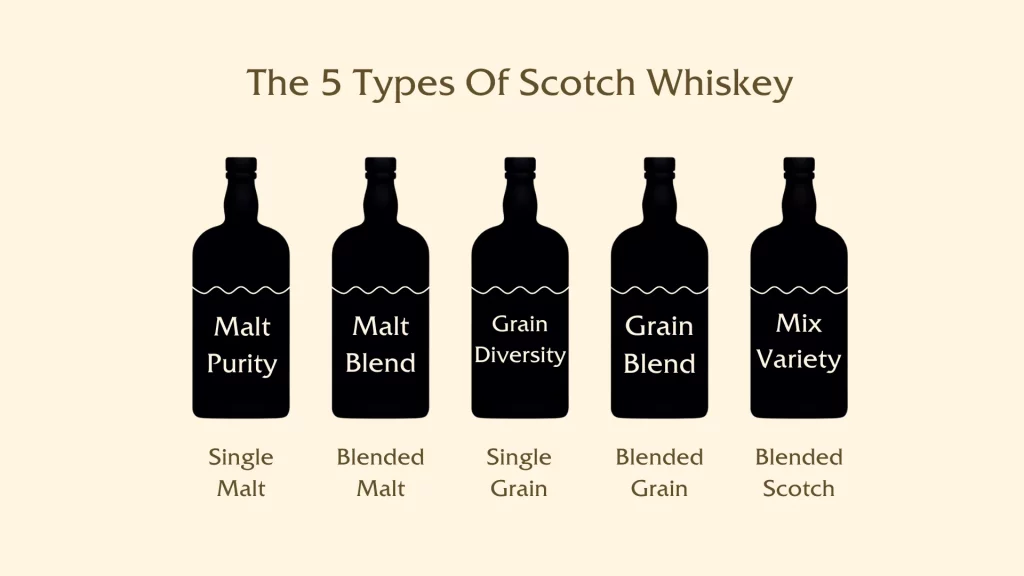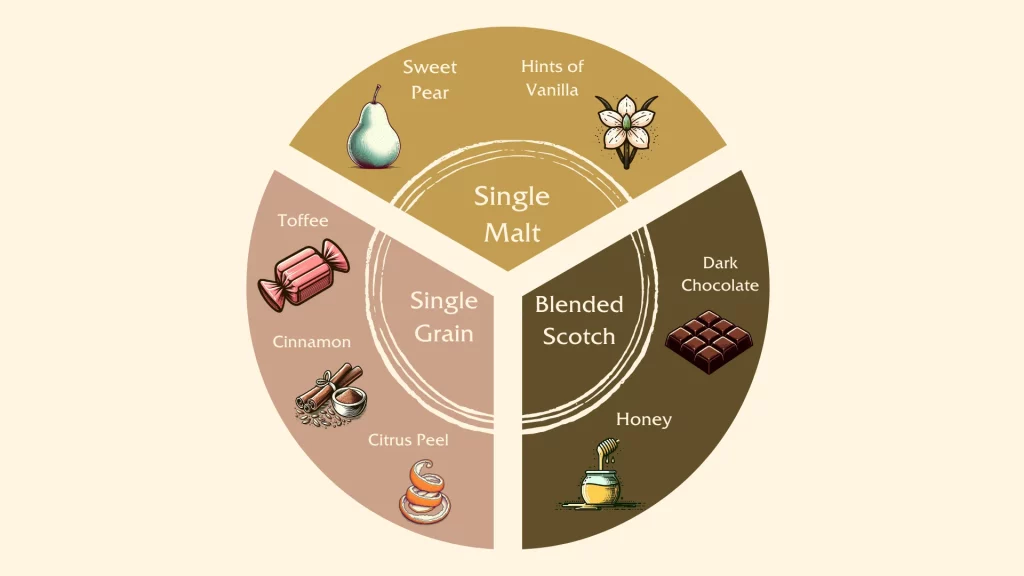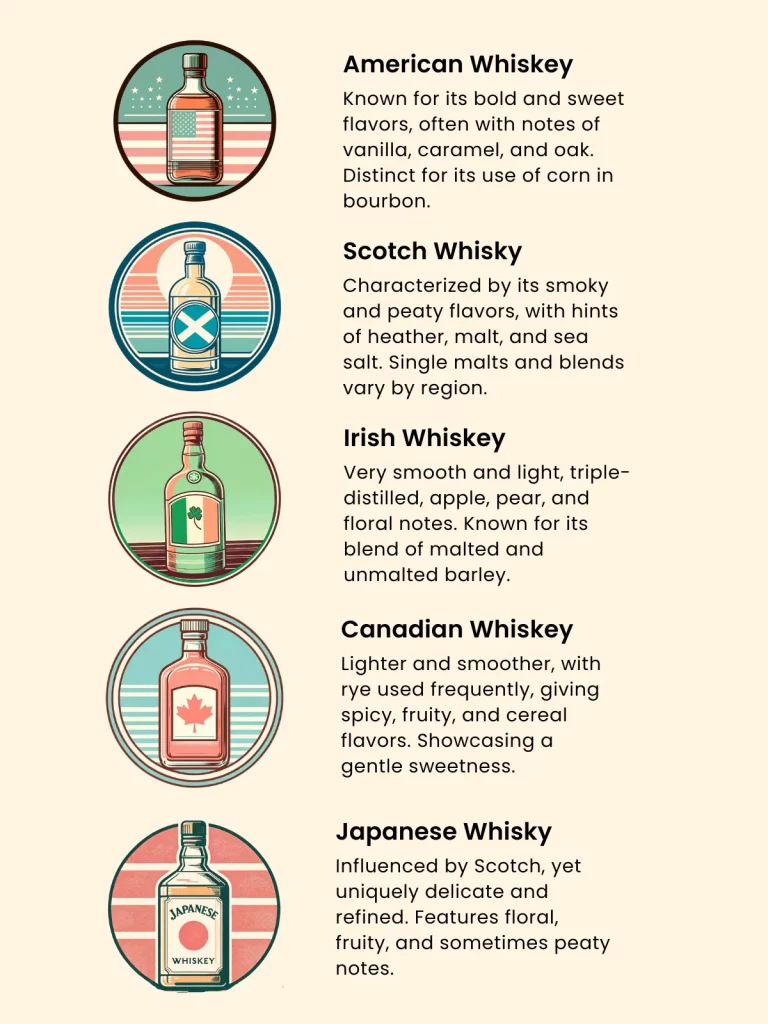Scotch Whisky embodies centuries of Scottish tradition and is celebrated worldwide for its complex flavors and varied styles.
Rooted in a history that spans back to the 15th century, Scotch Whisky reflects the craftsmanship and local customs of Scotland. From the peaty, smoky flavors of Islay malts to the light, floral notes of the Speyside region, this kind of tradition and regional diversity distinguish Scotch from other whiskies.
Below, we’ll embark on a comprehensive exploration of Scotch Whisky, dissecting its various classifications, illustrating how geographical nuances shape it’s flavor profile, and delving into the art of pairing Scotch with food.
Types of Scotch Whisky
Scotch Whisky unfolds into 5 distinct types, each distinguished by its unique flavor profile and method of production.
| Type of Scotch Whisky | Example | Flavor Profile | Notable Distillery/Brand |
|---|---|---|---|
| Single Malt Scotch | Glenfiddich 12 Year Old | Fruity and floral with a hint of pear | Glenfiddich |
| Blended Malt Scotch | Monkey Shoulder | Smooth and rich with spicy oak and mellow vanilla notes | Monkey Shoulder |
| Single Grain Scotch | Haig Club | Light and clean with sweet and fresh notes | Haig Club |
| Blended Grain Scotch | Compass Box Hedonism | Creamy and sweet with hints of vanilla and toffee | Compass Box |
| Blended Scotch Whisky | Johnnie Walker Black Label | Rich and complex with smoky finish | Johnnie Walker |
Each type of Scotch Whisky invites you to embark on a journey through Scotland’s rich distilling traditions, exploring a landscape of flavors that range from the deep and peaty to the light and floral.

Regions of Scotch Production
The landscape of Scotch Whisky is as varied as the regions of Scotland itself, each imparting its own distinctive flavors and whisky-making traditions.
| Region | Key Distillery | Notable Whisky | Flavor Characteristics |
|---|---|---|---|
| Campbeltown | Springbank | Springbank 10 Year Old | Complex, rich, with maritime and briny notes |
| Speyside | Glenfiddich | Glenfiddich 18 Year Old | Rich, with notes of baked apple, oak, and dried fruit |
| Islay | Laphroaig | Laphroaig 10 Year Old | Peaty and smoky, with a hint of seaweed and sweetness |
| Highland | Glenmorangie | Glenmorangie The Original | Floral, with citrus and peach, smooth and creamy |
| Lowland | Auchentoshan | Auchentoshan Three Wood | Smooth and complex, with notes of fruit and sherry |
Each region contributes its own chapter to the story of Scotch Whisky, offering enthusiasts a journey through Scotland’s rich distilling heritage and its beautiful, varied landscapes.

The Rich Flavor Spectrum of Scotch Whisky
Scotch Whisky’s flavor palette is as rich as its heritage, spanning from the smoky peat to gentle heather and ripe fruit. These tastes capture Scotland’s regional diversity, weaving the nation’s very essence into every glass.
If you want to appreciate all these subtle flavors, it’s helpful to familiarise yourself with the whiskey tasting process.
Signature Flavor Notes in Scotch Whisky
Scotch Whisky boasts an incredible array of flavors, spanning from the intense, peat-smoked character of Islay whiskies to the subtle, sweet, and fruity profiles typical of Speyside malts. This variety extends to the rich, honeyed textures of the Highlands, the maritime saltiness of coastal whiskies, and the gentle floral and creamy notes found in the Lowlands.
Each region’s unique climate, terrain, and distilling traditions contribute to the distinct taste experiences, making Scotch Whisky a world of flavors waiting to be explored.
Influence of Grain Bill on Flavor
The grain bill (or mash bill) plays a pivotal role in defining the flavor profile of Scotch Whisky, serving as the foundation upon which its distinctive taste is built. This carefully curated mixture of grains, predominantly malted barley, but sometimes including wheat, corn, or rye, determines the initial character of the whisky.
Malted barley gives Scotch its signature depth and complexity, with potential notes of chocolate, biscuit, or smoke, while the inclusion of other grains can introduce lighter, sweeter, or spicier nuances. The quality of the grains, their proportions in the blend, and the specific malting process they undergo, all contribute to the whisky’s final flavor, aroma, and texture.
The Role of Aging in Flavor Development
Aging is a critical process that significantly enhances the flavor complexity of Scotch Whisky. As the whisky rests in oak casks, it undergoes a remarkable transformation, absorbing the wood’s intrinsic characteristics and the environment’s subtle influences.
This interaction between the whisky and the oak introduces layers of richness, depth, and an array of nuanced flavors such as vanilla, caramel, fruit, and spice. The type of oak, the cask’s previous contents (whether it held sherry, bourbon, or wine) and the aging duration, all influence the whisky’s final taste profile. If you want to learn more about the usual production process of whisky, check out our article on the whiskey distillation process.
Pairing Scotch Whisky with Food
Pairing Scotch Whisky with food is all about finding matching flavors to make the most of your dining experience. It’s a fun way to see how the complex tastes of the whisky complement different dishes. Here’s a handy guide with some specific pairing ideas to try out:
| Type of Scotch | Food Pairing | Reasoning |
|---|---|---|
| Peaty Islay | Smoked Salmon | The smoky flavors of the whisky complement the richness and smokiness of the salmon. |
| Speyside | Roast Chicken with Herbs | The whisky’s sweet and fruity notes enhance the savory flavors of the chicken and herbs. |
| Highland | Grilled Steak | The robust and spicy character of Highland Scotch stands up to the bold flavors of grilled steak. |
| Lowland | Cheesecake | The light and floral notes of Lowland Scotch provide a refreshing contrast to the creamy dessert. |
| Blended Scotch | Chocolate Truffles | The complex flavors in blended Scotch are accentuated by the richness of the chocolate. |
Complementing Flavors in Savory Dishes
In the realm of savory dishes, Scotch Whisky acts as a culinary enhancer, meticulously complementing and elevating the flavors on the plate. For example, the peaty and smoky whiskies from Islay excel alongside hearty meats like smoked salmon, infusing an additional layer of depth and complexity that accentuates the dish’s inherent flavors.
For lighter fare, such as roast chicken with herbs, whiskies with spicy or herbal undertones from the Highland region introduce a fascinating flavor dynamic, creating a delightful contrast that enhances the meal’s overall taste. The secret lies in balancing the whisky’s intensity with the dish’s flavors, ensuring a harmonious and enriched dining experience.
Complementing Flavors in Sweet Dishes
When it comes to sweet dishes, the right Scotch Whisky pairing can transform dessert into an extraordinary taste experience. Whiskies showcasing sweet, fruity, or creamy characteristics, such as those from Speyside, are a natural fit for desserts, complementing everything from rich chocolates to creamy cheesecakes.
The whisky’s complexity cuts through the sweetness, adding a sophisticated richness that elevates the dessert. Opting for a whisky with notes of vanilla or caramel can mirror and enhance the dessert’s flavors, achieving a perfect balance and a luxurious end to any meal.
Which Scotch Whisky Should You Try First?
Embarking on the journey of finding the best Scotch Whisky exploration begins with selecting the right bottle to match your taste. Here’s a detailed table showcasing specific recommendations based on flavor preferences:
| Flavor Preference | Whisky Recommendations | Description |
|---|---|---|
| Gentle and Smooth | Glenkinchie 12 Year Old, Auchentoshan American Oak | These whiskies are known for their light and approachable profiles, perfect for those new to Scotch. |
| Bold and Spicy | Talisker 10 Year Old, Highland Park 12 Year Old | Offering a robust flavor profile with notes of spice and smoke, these selections are ideal for those seeking intensity. |
| Sweet and Rich | Glenmorangie Quinta Ruban, Aberlour A’bunadh | With their rich, dessert-like qualities, these whiskies are perfect for those who enjoy sweeter spirits. |
| Peaty and Smoky | Laphroaig 10 Year Old, Ardbeg 10 Year Old | Characterized by their strong peaty and smoky flavors, these whiskies are for the adventurous palate. |
For individuals drawn to the softer side of Scotch, whiskies like Glenkinchie 12 Year Old and Auchentoshan American Oak serve as the perfect introduction. These whiskies embody the elegance and subtlety of Scotch, providing a welcoming entry point for those exploring this distinguished spirit.

For Enthusiasts of Bold, Spicy Notes
Adventurous palates craving depth and intensity will find satisfaction in whiskies such as Talisker 10 Year Old and Highland Park 12 Year Old. These selections invite enthusiasts on a flavorful journey, marked by their vibrant and complex profiles that capture the essence of Scotland’s diverse terroir.
For Lovers of Sweet, Rich Profiles
Those with an affinity for sweetness and complexity in their whisky will be enchanted by selections like Glenmorangie Quinta Ruban and Aberlour A’bunadh. These whiskies are a celebration of the art of Scotch whisky making, showcasing the harmonious balance between the spirit and the influence of the cask.
For Admirers of Peaty, Smoky Whiskies
For those who relish the intense, peaty, and smoky flavors of Scotch, whiskies such as Laphroaig 10 Year Old and Ardbeg 10 Year Old offer a profound and memorable experience. These whiskies embody the rugged essence of their island origins, providing a bold exploration of Scotch’s smokier side.
This detailed table and descriptions aim to guide readers through the initial stages of their Scotch Whisky exploration, ensuring a rewarding and enjoyable experience tailored to their flavor preferences.
Regulation Requirements Of Scotch Whisky
Scotch Whisky is governed by strict regulations that uphold its authenticity and quality, ensuring the spirit’s storied heritage is preserved. To qualify as Scotch, the whisky must be distilled and aged in Scotland for at least three years in oak barrels, a requirement that imbues it with its distinctive character.
Furthermore, it must be distilled to an alcohol by volume (ABV) of less than 94.8% and bottled at a minimum of 40% ABV. These standards not only maintain the traditional craftsmanship but also dictate the use of specific ingredients (water, malted barley, and other cereals) while strictly prohibiting any artificial flavorings or additives.
Prohibition of Artificial Flavorings Preserving Authenticity
The strict prohibition of artificial flavorings in Scotch Whisky production ensures that the flavors in the final product are derived purely from the natural ingredients and the distillation and aging processes. This regulation preserves the authenticity and integrity of Scotch Whisky, ensuring that each bottle offers a genuine taste of Scotland’s natural environment and distilling heritage.
By relying on traditional methods and natural ingredients, Scotch Whisky producers can craft spirits that truly reflect the character of their specific region, from the peaty smokiness of Islay whiskies to the floral delicacy of Lowland drams.
Such rigorous regulation ensures that every bottle bearing the name “Scotch Whisky” is a testament to Scotland’s unparalleled distilling expertise and traditions, offering consumers a genuine and high-quality spirit that is uniquely Scottish. These regulations not only protect the reputation of Scotch Whisky worldwide but also enhance the appreciation of its rich and diverse flavor spectrum among enthusiasts.
History of Scotch Whisky
The history of Scotch Whisky weaves a rich narrative of tradition, innovation, and the enduring spirit of Scotland. Its roots extend to early distillation techniques, with the first recorded production in the 15th century by monks, who distilled it as a medicinal elixir. This humble beginning marked the genesis of a journey that would see Scotch evolve from a local craft to a globally revered spirit.
The 18th century brought significant changes, with the legalization and taxation of distilleries shaping the industry’s future. The Excise Act of 1823 was particularly transformative, encouraging the establishment of licensed distilleries and setting the foundation for Scotch Whisky’s international acclaim.
As Scotch Whisky ventured beyond Scottish borders in the 19th and 20th centuries, it became a symbol of Scottish heritage and excellence, admired and enjoyed worldwide. This journey from monastic elixirs to global prestige underscores the deep history and cultural significance of Scotch Whisky, celebrating its legacy as a timeless icon of Scotland.
Historical Milestones and Anecdotes
- 1494 – The First Recorded Mention: The earliest documented evidence of whisky production in Scotland comes from the Exchequer Rolls of 1494, which mention “Eight bolls of malt to Friar John Cor, by order of the King, wherewith to make aqua vitae.”
- 1823 – The Excise Act: This pivotal legislation allowed distilleries to operate with a license, significantly reducing illegal production. It laid the groundwork for the modern Scotch Whisky industry and encouraged quality and innovation.
- Glenlivet’s Bold Move: In 1824, George Smith of the Glenlivet distillery became the first in the Speyside region to take out a license under the new Excise Act, setting a precedent that many others would follow. This bold step helped establish Speyside as a leading Scotch Whisky production area.
- Global Expansion: The late 19th and early 20th centuries saw Scotch Whisky’s reputation grow internationally, thanks in part to the phylloxera epidemic that devastated French vineyards and cognac production. Scotch filled the void in the global spirits market, cementing its status as a premium product.
- Prohibition and Scotch: The American Prohibition era (1920-1933) paradoxically boosted Scotch Whisky’s profile. While domestic production and sale of alcohol were banned in the United States, Scotch, produced legally in Scotland, found its way into the country, enhancing its allure and desirability.
- The Single Malt Surge: The late 20th century witnessed a surge in the popularity of single malt Scotch, a category that had previously been overshadowed by blended whiskies. Distilleries began marketing single malts as premium offerings, highlighting their unique characteristics and terroir.
Comparing Scotch Whisky To Other Whiskeys
Scotch Whisky, with its distinctive character and heritage, holds a revered spot in the vast landscape of global spirits. Each whiskey category reflects the cultural, geographical, and historical nuances of its region, presenting enthusiasts with a diverse array of flavors and experiences.
Scotch Whisky’s commitment to tradition, coupled with its complex flavor spectrum and stringent production regulations, solidifies its esteemed status among whiskey varieties worldwide.

Scotch Whisky vs Canadian Whisky
Scotch Whisky stands apart from Canadian Whisky in both its production rigor and flavor diversity. Scotch is celebrated for its vast flavor spectrum, from the peaty and smoky to the light and floral, directly tied to the specific regions of Scotland.
In contrast, Canadian Whisky is characterized by its smoothness and versatility, often with a rye-heavy mash bill that imparts a spicier edge. The stringent regulations surrounding Scotch production ensure a consistent and authentic expression of its heritage, distinguishing it from the broader, more adaptable Canadian Whisky standards.
Scotch Whisky vs American Whiskey
The comparison between Scotch Whisky and American Whiskey reveals a distinct divergence in flavor and tradition. American Whiskeys, particularly bourbons, are noted for their sweet, vanilla, and caramel notes, a result of aging in new charred oak barrels. Scotch, with its regional variety, offers everything from smoky Islay malts to gentle Speyside drams, reflecting the rich tapestry of Scottish terrain and tradition.
This contrast underlines the cultural and historical differences that define each whiskey style, from the heart of Scotland to the spirit of America.
Scotch Whisky vs Japanese Whisky
While Scotch Whisky and Japanese Whisky share a foundational connection, Japanese Whisky distinguishes itself through its elegance and precision. Influenced by Scotch in method and style, Japanese Whisky often presents a lighter, more refined profile, with a keen focus on the subtleties of distillation and maturation.
The unique characteristics of Japan’s environment add distinct nuances to its whisky, creating a gentle divergence from Scotch. Both are lauded for their exceptional craftsmanship and quality, yet each offers a unique lens through which to explore the world of whisky, reflecting their respective cultures and distilling philosophies.





